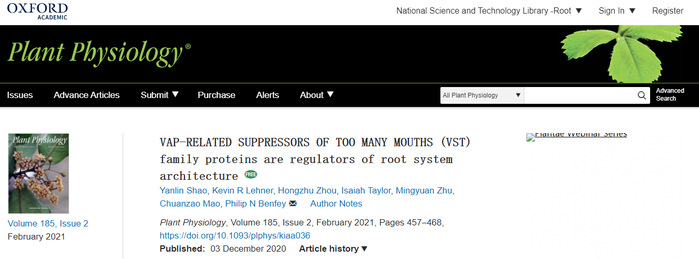
Title: VAP-RELATED SUPPRESSORS OF TOO MANY MOUTHS (VST) family proteins are regulators of root system architecture
Yanlin Shao, Kevin R Lehner, Hongzhu Zhou, Isaiah Taylor, Mingyuan Zhu, Chuanzao Mao, Philip N Benfey Author Notes
Plant Physiology, Volume 185, Issue 2, February 2021, Pages 457–468, https://doi.org/10.1093/plphys/kiaa036
Published: 03 December 2020
Abstract
Root system architecture (RSA) is a key factor in the efficiency of nutrient capture and water uptake in plants. Understanding the genetic control of RSA will be useful in minimizing fertilizer and water usage in agricultural cropping systems. Using a hydroponic screen and a gel-based imaging system, we identified a rice (Oryza sativa) gene, VAP-RELATED SUPPRESSOR OF TOO MANY MOUTHS1 (OsVST1), which plays a key role in controlling RSA. This gene encodes a homolog of the VAP-RELATED SUPPRESSORS OF TOO MANY MOUTHS (VST) proteins in Arabidopsis (Arabidopsis thaliana), which promote signaling in stomata by mediating plasma membrane–endoplasmic reticulum contacts. OsVST1 mutants have shorter primary roots, decreased root meristem size, and a more compact RSA. We show that the Arabidopsis VST triple mutants have similar phenotypes, with reduced primary root growth and smaller root meristems. Expression of OsVST1 largely complements the short root length and reduced plant height in the Arabidopsis triple mutant, supporting conservation of function between rice and Arabidopsis VST proteins. In a field trial, mutations in OsVST1 did not adversely affect grain yield, suggesting that modulation of this gene could be used as a way to optimize RSA without an inherent yield penalty.
Link:https://academic.oup.com/plphys/article/185/2/457/6017828





